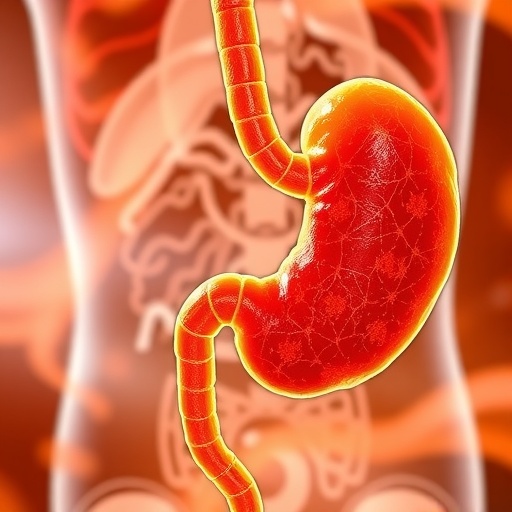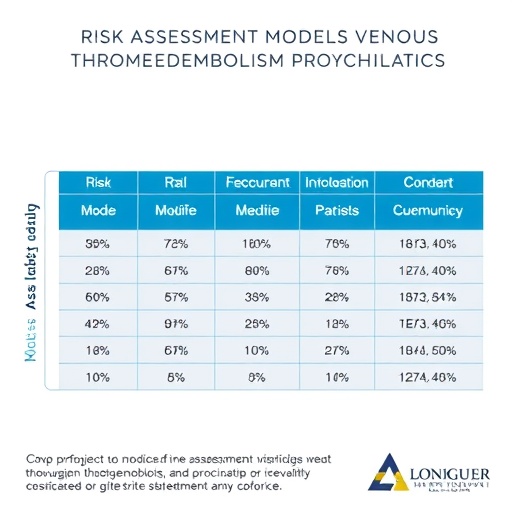In a groundbreaking revelation that could alter the therapeutic landscape of gastric cancer, researchers have identified a novel protein encoded by a circular RNA, named circUBE2G1, which suppresses the metabolic pathway of glycolysis by directly interacting with the enzyme ENO1. This pioneering study, recently published in Cell Death Discovery, unveils intricate molecular mechanisms underlying the metabolic reprogramming in gastric cancer cells—a hallmark of malignant progression—and offers fresh avenues for targeted cancer therapy.
The metabolic reprogramming of cancer cells, often termed the Warburg effect, is characterized by an enhanced glycolytic flux even under oxygen-sufficient conditions, enabling rapid energy production and biosynthesis to support uncontrolled proliferation. ENO1, or alpha-enolase, is a key glycolytic enzyme catalyzing the conversion of 2-phosphoglycerate to phosphoenolpyruvate, a critical step in the glycolytic pathway. Aberrant activity of ENO1 has been frequently observed in cancers and is associated with tumor aggressiveness and poor prognosis.
What distinguishes this study is the identification of circUBE2G1, a circular RNA previously considered non-coding, now found to harbor coding potential producing a previously unidentified functional protein. Circular RNAs (circRNAs) have emerged as significant players in gene regulation, but the concept that some also encode peptides or proteins is an evolving and somewhat surprising field. The discovery that circUBE2G1 yields a protein capable of modulating key metabolic enzymes injects a surprising twist into the biology of circRNAs and tumor metabolism.
.adsslot_egyZFwVsDc{width:728px !important;height:90px !important;}
@media(max-width:1199px){ .adsslot_egyZFwVsDc{width:468px !important;height:60px !important;}
}
@media(max-width:767px){ .adsslot_egyZFwVsDc{width:320px !important;height:50px !important;}
}
ADVERTISEMENT
Delving deep into the molecular interplay, the researchers demonstrated that the circUBE2G1-derived protein binds specifically to ENO1, altering its enzymatic activity. Functional assays revealed that this binding modulates glycolytic flux, thereby suppressing the enhanced glycolysis typically observed in gastric cancer cells. This metabolic suppression was reflected in reduced lactate production, diminished glucose uptake, and ultimately, impaired cell proliferation—directly linking the circUBE2G1-encoded protein to the energetic economy of malignant cells.
To unveil these findings, the team employed a multi-layered experimental approach. Initially, bioinformatic analyses of gastric cancer transcriptomes pinpointed circUBE2G1 as an abundant circRNA with uncharacterized coding potential. Subsequent proteomic mass spectrometry confirmed the presence of the novel protein product encoded by circUBE2G1. Structural modeling and co-immunoprecipitation assays substantiated the physical interaction between this protein and ENO1, illuminating the molecular basis of their functional relationship.
Moreover, the researchers observed that overexpression of circUBE2G1 or its protein product in gastric cancer cell lines resulted in marked suppression of glycolytic activity, whereas knockdown experiments reversed this effect. This bidirectional modulation firmly established circUBE2G1 protein as a critical regulator of tumor metabolism. Importantly, in vivo tumor xenograft models corroborated the in vitro findings, showing that circUBE2G1 protein expression effectively hampered tumor growth, hinting at translational potential.
From a clinical perspective, the expression levels of circUBE2G1 and its encoded protein correlated inversely with ENO1 activity and tumor aggressiveness in patient-derived tissue samples. This inverse correlation points towards a tumor-suppressive role of the circUBE2G1 protein and lays the groundwork for future biomarker development. Therapeutic strategies aiming at augmenting the function or expression of this novel protein could therefore emerge as a promising intervention to disrupt the aberrant glycolytic machinery sustaining gastric cancer progression.
Notably, the study’s implications extend beyond gastric cancer, as dysregulated glycolysis is a common feature across various malignancies. The discovery of a circRNA-derived protein capable of modulating metabolic enzymes invites researchers to reconsider the functional repertoire of circRNAs in cancer biology and metabolism. It also raises intriguing questions about the hidden coding landscape of circular RNAs and their potential contributions to cellular homeostasis and disease.
The methodology deployed—a combination of cutting-edge RNA sequencing, ribosome profiling to confirm translation, and comprehensive metabolomic profiling—showcases a robust strategy for uncovering cryptic protein products within presumed non-coding RNA territories. Such approaches could be replicated across diverse cancer types to unveil novel metabolic regulators and expand the compendium of druggable targets.
The precise structural features enabling circUBE2G1-derived protein to bind ENO1 were dissected using advanced protein modeling software, revealing a unique interaction domain that might be exploited for drug design. Therapeutic molecules mimicking or enhancing this interaction could attenuate glycolysis in tumors, curtailing their growth and metastasis.
Furthermore, this work enriches the evolving narrative about the role of circular RNAs in cancer progression. Traditionally seen as microRNA sponges or transcription regulators, the coding potential of circRNAs introduces an entirely new biological paradigm, complicating yet enriching our understanding of gene expression regulation in malignant cells.
In summary, this landmark study not only identifies a novel circRNA-derived protein as a metabolic gatekeeper in gastric cancer but also underscores the therapeutic promise held by targeting metabolic vulnerabilities through unconventional molecular players. The findings herald a new chapter in cancer metabolism research, where the crosstalk between RNA species and enzymatic regulators might be manipulated to devise sophisticated antitumor strategies.
As this research gains traction, one can anticipate a surge in efforts to characterize other circRNA-encoded proteins and their roles across diverse cellular processes. This expanded view could ultimately lead to a more nuanced and effective repertoire of therapeutic interventions tailored to the metabolic idiosyncrasies of individual tumors.
In the battle against gastric cancer—a malignancy notorious for its poor prognosis and limited treatment options—the circUBE2G1 protein opens a window of hope. By targeting the metabolic lifelines that tumors depend upon, this novel protein could serve as a blueprint for next-generation metabolic inhibitors that are both precise and potent.
The convergence of circRNA biology, protein-coding potential, and cancer metabolism not only challenges established dogmas but also offers fertile ground for innovation. As science continues to uncover the hidden layers of gene regulation and their pathological implications, discoveries like this one will light the path toward more effective and personalized cancer therapies.
Subject of Research: Novel protein encoded by circUBE2G1 and its role in suppressing glycolysis in gastric cancer through interaction with ENO1.
Article Title: A novel protein encoded by circUBE2G1 suppresses glycolysis in gastric cancer through binding to ENO1.
Article References:
Lu, L., Guo, G., Guo, J. et al. A novel protein encoded by circUBE2G1 suppresses glycolysis in gastric cancer through binding to ENO1. Cell Death Discov. 11, 350 (2025). https://doi.org/10.1038/s41420-025-02644-0
Image Credits: AI Generated
DOI: https://doi.org/10.1038/s41420-025-02644-0
Tags: alpha-enolase and tumor aggressivenesscircUBE2G1 proteincircular RNA in cancer therapyENO1 enzyme interactiongastric cancer glycolysis inhibitionglycolytic pathway in malignancymetabolic reprogramming in cancermolecular mechanisms in cancer metabolismnon-coding RNA functionsnovel protein coding potentialtargeted cancer therapy innovationsWarburg effect in gastric cancer





